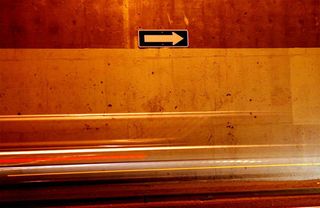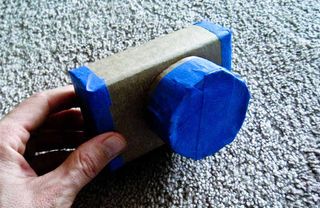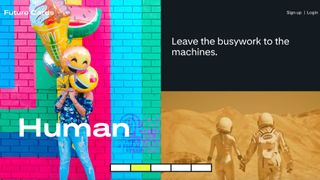Four secrets to enhancing creative productivity
Don't beat your head against a wall. Speaker and author Denise Jacobs presents four unconventional ways to help you get your creative productivity on
While most people attempt to force great ideas of out themselves by relentless pursuit of an answer to a problem or straining to think up original ideas, they don't realise that most truly great ideas are borne from a more hands-off approach that comes from the back and forth dance between concentrated and diffused focus.
While most people attempt to force great ideas of out themselves by relentless pursuit of an answer to a problem or straining to think up original ideas, they don't realise that most truly great ideas are borne from a more hands-off approach that comes from the back and forth dance between concentrated and diffused focus.
The road less travelled
Creative bursts occur when discrete bits of information stored in the brain connect along new neural pathways. Unfortunately, most people are typically overloaded and exhausted mentally and in a stressed state when trying to produce good work. Despite their best efforts, their brains travel along well-worn, established pathways, and they literally have one-track minds.

Clearly, a one-track mind is no place to generate awesome ideas. But, if one thing were ever true, it's that you can't force creativity: it needs incubation, downtime, and the space to happen on its own schedule. However, just because you can't force creativity doesn't mean you can't give it the proper encouragement. Let's take a look at four lesser-known secrets for increasing creative productivity.
01. Tinker
"Tinker?" you ask, and the answer is "yes, ‘tinker’".
I’m sure you’re probably well-familiar with the process for generating ideas: after establishing the creative parameters and restraints, you immerse yourself in as much information as you can for idea incubation. Then, you give yourself the time and space to encourage the flow of as many ideas out of your head as possible. This is the point where you need to winnow out the most viable of all of these brilliant ideas. Tinkering is one of the best ways to do so.
By tinkering, I mean playing with ideas: particularly taking one and expanding it out to see how workable it is. This can be in a tangible sense, in terms of building a lo-fidelity prototype of an object, to sketching out ideas for logos, designs or typefaces, to programming rough mockups of apps or interfaces. This can also be in a more conceptual sense of mapping out strategies for execution, brainstorming necessary steps and key players needed, and visualising the outcome of different approaches to making the idea(s) happen. A great way to tinker conceptually is to talk an idea through with someone.
Get the Creative Bloq Newsletter
Daily design news, reviews, how-tos and more, as picked by the editors.

Why tinker? So often we think we have to have an idea in its most perfect form (ahem, perfectionists) before we can execute it, whereas via tinkering, we can actually spark more and even better ideas. Tinkering can stimulate an "idea trail": a series of idea sparks that will lead us much more quickly to workable, and potentially, brilliant solutions.
The trick with tinkering is to get started earlier in the process rather than later. Remember that the point of creative innovation is to generate ideas, evaluate them, execute, and reiterate.
Also, remember that during the tinkering process, you need to stick with fleshing out your ideas over time. But this doesn't mean working tirelessly – you need to take breaks.
02. Space out
What better thing to do during a break than to space out? Well, now you can completely justify times when you are bouncing a ball against the wall, staring off into space, or taking a walk with no particular destination. All of these activities (or lack thereof), have been shown to be part of the key to initiating the big-picture thinking that sparks the connection of far-flung pieces of information in your brain. In short, spacing out, notably in the form of daydreaming is one of the quickest routes to 'aha' that a person can take.

If you are feeling sceptical (or maybe even a little guilty) about this technique, rest assured that neuroscience supports it. Studies have shown that the brain actually becomes more energetic as mental activity decreases. As brainwaves slow down and move from Beta to Alpha, a characteristic of the brain called latent inhibition also drops as well. Because the brain is now able to consider the seemingly irrelevant as relevant, it revs up by creating and traveling down new neural pathways. The outward result? Ideas bubble to the surface of your conscious mind that you were unable to access previously.
03. Engage in mindless activity
We give our conscious minds far more credit than they deserve in terms of being the source of creative ideas. In truth, the 4 per cent of our brains that is in charge of conscious thought is merely window-dressing for the subconscious 96 per cent that is the source of our infinite creative outflux.
The natural companion to spacing out is mindless activity – which is frequently the vehicle for spacing out. Any activity that is both rhythmic, repetitive, and requires little conscious thought is ideal for giving your subconscious the much-needed time to shift through all the information that you’ve saturated it with and to start making new connections between distant concepts to form new ones.
Don’t think for one moment that mindless activity takes you off track from getting to your big idea. Like above techniques, it is a necessary part of the creative process. If you’re so out of practice that you can’t think of any mindless activities to engage in, here are some to inspire you: doodling, driving, playing an instrument, knitting, gardening, cooking, showering; watching a sunset, sunrise or waves; cleaning, washing dishes, playing with kids; constructing something from toy blocks, lego, or toy model; gaming; working a puzzle: crossword, Sudoku, and so on; rearranging shelves, closet, or office; organising small things such as buttons, screws, beads, or your desk drawers.
Any of these activities will get you to a place to where your brain is relaxed enough to where new ideas can rise to the surface of your consciousness where you’ll actually be able to put them into action and bring them to life – which is the essence of innovation.
04. Laugh
Finally, in order to help along the process of getting to new ideas, you can get laugh it all off, literally.
Like spacing out and daydreaming, laughing relaxes the brain and allows the left brain to fade into the background as the right brain steps forward. And yes, science supports this as well: laughter has been found to increase creativity, productivity and collaboration.

There are two kinds of laughing and both are effective. The first is conditional laughing, which is laughing at or in response to something: a joke, a comic, a funny story, etc. The second is unconditional laughter, which is not dependent on anything external but just comes from inside of you.
Either kind of laughter will shift your brain to a state of relaxed childlike openness (which is a good thing), while also providing the added benefits of decreasing stress hormones and boosting the immune system. It may also be the perfect precursor for the sudden increase in gamma brainwaves that accompany an 'aha' or eureka moment.
Don’t fight the paradox, embrace it
In his presentation The Shape of Design at Build Conference 2010, Frank Chimero suggests that "creativity is about embracing paradox".
While above techniques fly in the face of standard approaches to being productive, we've all experienced getting great ideas through these methods whether we were aware of it or not. By deliberately adding these practices to your innovation arsenal, you will not only create more, better, and faster, but you’ll also have an enjoyable time doing so.
Words: Denise Jacobs
Denise is a speaker and author who evangelizes techniques to make the creative process more fluid, methods for making work environments more conducive to creative productivity, and practices for sparking innovation. Follow her on Twitter @denisejacobs.
Main image: Brainstorm, by Rubn Chase

Thank you for reading 5 articles this month* Join now for unlimited access
Enjoy your first month for just £1 / $1 / €1
*Read 5 free articles per month without a subscription

Join now for unlimited access
Try first month for just £1 / $1 / €1
The Creative Bloq team is made up of a group of design fans, and has changed and evolved since Creative Bloq began back in 2012. The current website team consists of eight full-time members of staff: Editor Georgia Coggan, Deputy Editor Rosie Hilder, Ecommerce Editor Beren Neale, Senior News Editor Daniel Piper, Editor, Digital Art and 3D Ian Dean, Tech Reviews Editor Erlingur Einarsson and Ecommerce Writer Beth Nicholls and Staff Writer Natalie Fear, as well as a roster of freelancers from around the world. The 3D World and ImagineFX magazine teams also pitch in, ensuring that content from 3D World and ImagineFX is represented on Creative Bloq.




